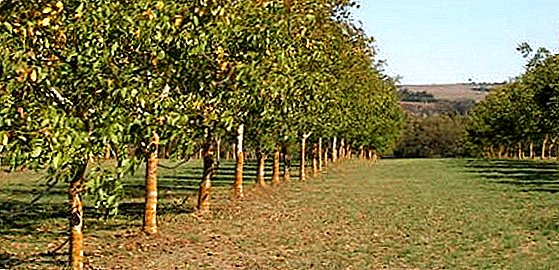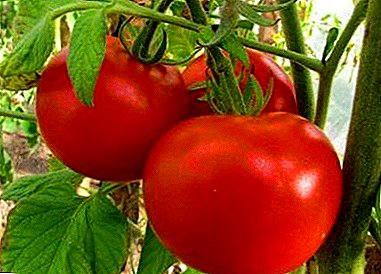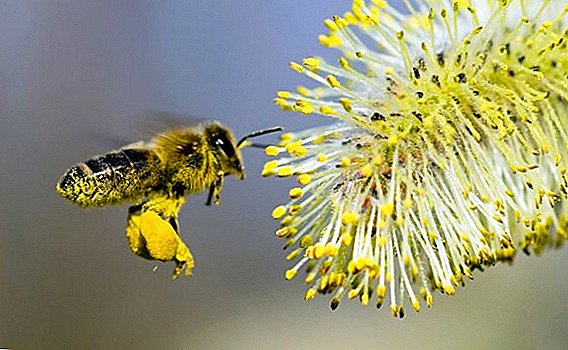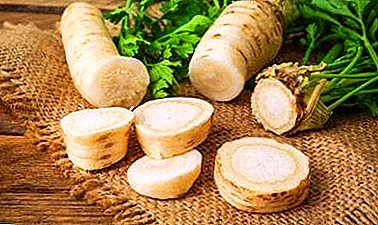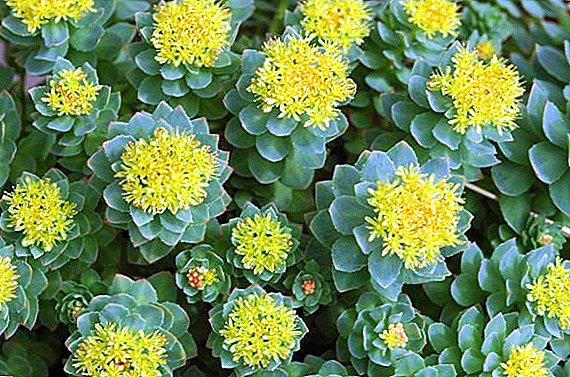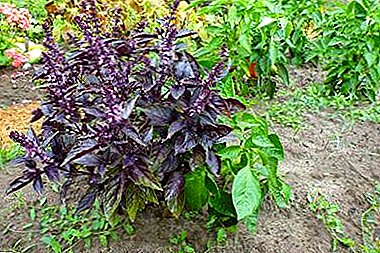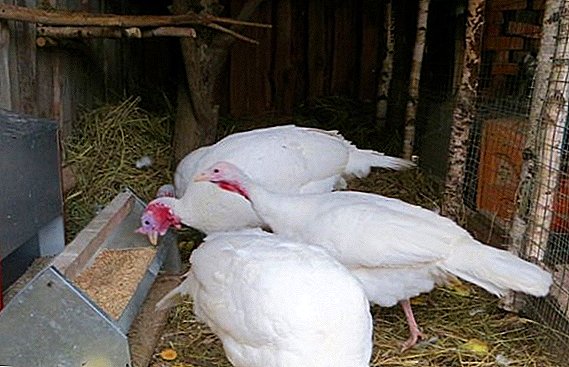 To quickly improve the productive characteristics of birds, such as egg production, meat quality, live weight, precocity, breeders breed cross. In this article we will talk about the breed of turkeys Victoria, we will learn its features, conditions of detention and feeding.
To quickly improve the productive characteristics of birds, such as egg production, meat quality, live weight, precocity, breeders breed cross. In this article we will talk about the breed of turkeys Victoria, we will learn its features, conditions of detention and feeding.
History of cross
The main breeding material for the creation of the Victoria cross was a wide-breasted white breed.  The white, wide-breasted breed, the Fatherly material of the breed, was distinguished by its rapidly gained large dimensions, well developed muscles of the chest and legs. The maternal line was characterized by high egg production and precocity. Taking their best qualities from their parents, the crosses turned out to be more productive, viable and quickly paid for.
The white, wide-breasted breed, the Fatherly material of the breed, was distinguished by its rapidly gained large dimensions, well developed muscles of the chest and legs. The maternal line was characterized by high egg production and precocity. Taking their best qualities from their parents, the crosses turned out to be more productive, viable and quickly paid for.
These qualities signal a profitable breeding of crosses, especially for small and households. Note that this cross was obtained by breeders of the North Caucasian Experimental Economy of Russia, and is the best result of breeding lately.
Check out a selection of breeds and crosses of turkeys for home breeding.
External features and character
Birds have snow-white plumage without inclusions, correctly folded torso, muscular broad chest, developed leg muscles. The head is small, without plumage, rich pink color. Wings must be trimmed to avoid overflight.
Birds are hardy, stress-resistant, unpretentious in food and to conditions. Endowed with excellent survival qualities. So, no more than 10% of young stock die under natural conditions and no more than 20% - in an incubator. Turkeys are energetic birds, love movement and free range. If these conditions are met, they will grow big and strong. 
Productive qualities
Representatives of Victoria Cross have the following productive characteristics:
- slaughter age of males - 22 weeks, females - 20;
- live weight of turkey - up to 13 kg, turkeys - 9 kg;
- laying hens' egg production rate is 4-5 eggs per week, which is about 85 eggs per reproductive period;
- the average weight of one egg is 87 grams;
- egg color - light cream.
Learn more about the beneficial properties and use of turkey eggs, liver, meat.
Conditions of detention
Cross victoria is suitable for keeping in poultry houses and cages. The main thing is to observe the elementary concepts of dryness, cleanliness and light, because these turkeys are very unpretentious. However, one should not forget that the better the care, the better the bird productivity. 
Requirements for the room
If your poultry will be kept in the house, it is necessary:
- to build (choose) a room spacious, bright, without drafts, but well ventilated;
- provide a dry litter of straw or hay, which must be changed after 3-4 weeks or as far as pollution (otherwise the smell of ammonia can not be avoided);
- provide uninterrupted consumption of clean water;
- put special containers with ashes and sand for cleaning feathers;
- equip the room with perches for a night rest;
- monitor the integrity of feeders and drinkers, because spilled water and scattered food rot quickly;
- try for each individual to allocate personal space next to the feeder (about 20 cm), and for the drinker 4 cm
- take care of the natural change of day and night, that is, at night in the room should be dark, and in the daytime - light from the penetrating sunlight.
Read more about building a turkey-hen with his own hands.
There are no special recommendations for the temperature regime, with the exception of nursing small turkey poults. 
Features of breeding in cages
Almost all of the above recommendations can be applied to breeding turkeys in cages. But the main condition for the productive content of victoria crosses will be the observance of the following rule: one individual should have one square meter of free space (area). In addition, cells are advised to transfer to fresh air during the daytime, periodically changing the location. It is also important to respect the change of real time of day and night.
Did you know? Turkey's stomach is able to digest glass and iron, so strong grains of corn and cereals do not care for it.
What else should you take care
We must not forget about the arrangement for the crosses of the required number of nests, feeding troughs, drinking bowls and a special place for walking (perhaps not one).
Nest
Equally important when laying eggs are nests. They should be comfortable, located in a quiet dark place. The best option would be to install a sloping roof over the nest, eliminating the possibility of bird landing. The number of nests is regulated depending on the number of female Victoria Cross. No more than five turkeys claim for one nest. 
Feeders and drinkers
You can keep birds cellular and outdoor methods. The choice does not affect the speed and amount of weight gained by crosses. Access to drinkers and feeders should be free and around the clock. The fight between individuals for food and water signals an insufficient number of containers.
Learn how to make your own turkey drinkers.
Fence area for walking
To prevent obesity and maintain health, crosses need constant walking. For this purpose, free sites (open-air cages) are used that do not restrict access to water and vegetation, equipped with protective sheds from precipitation and wind, fenced with a high fence. Cellular birds are carried to green areas during the day.
Did you know? The turkeys are taken not to beat lying, so the one who lay down and stretched his neck, considers himself saved from the massacre.
What to feed
Following the established norms of food ration for chicks is a guarantee of their survival, and for adult birds - high productivity. 
Youngsters
The young growth is growing rapidly, which means that they need to be fed often. Ten days after birth, he is fed every two hours, gradually reducing the number of feedings to five times a day. The age of chicks at the same time reaches 30 days old. The first two weeks turkey chicks receive only wet mash. Next, they must be alternated with dry food. In spring and summer, 2-month-old birds are sent for walking.
Important! Wet mash young animals prepare strictly half an hour (hour) before feeding. The remaining food in the trough, not eaten in 35 minutes, is removed.
Let us give an example of a balanced diet of the younger generation of Victoria Cross:
- 1-3 days - wet mash: boiled egg, small grains, finely chopped greens, fish oil - 20 g per 1 kg of feed;
- 4-11 days wet mash: boiled egg, small grits, finely chopped greens, crushed chalk and shell, fresh cottage cheese, fish oil - 20 g per 1 kg of feed;
- 12-21 days - wet mash: boiled potatoes, boiled egg, small grains, finely chopped greens, crushed chalk and shell, fresh cottage cheese, meat and bone meal, boiled meat waste, milk, inverse, sour milk, mash from special feed on sour milk or buttermilk, fish oil - 20 g per 1 kg of feed;
- 21-30 day - to the diet add finely crushed grain - corn, wheat, oats.
 Necessary mineral supplements (chalk, shell, charcoal, gravel) are placed separately in special feeders. Forty-day turkey henbush can be diluted with water, not dairy products. For young animals 1-9 weeks of life requires 30% of the proteins of the total mass of feed. For 10 weeks, 8 months for living turkey poults - 25%, and for 8 months and beyond - 15% of proteins. The less turkey poults, the more they consume protein.
Necessary mineral supplements (chalk, shell, charcoal, gravel) are placed separately in special feeders. Forty-day turkey henbush can be diluted with water, not dairy products. For young animals 1-9 weeks of life requires 30% of the proteins of the total mass of feed. For 10 weeks, 8 months for living turkey poults - 25%, and for 8 months and beyond - 15% of proteins. The less turkey poults, the more they consume protein.
Familiarize yourself with the main breeds and characteristics of broiler turkeys.
Adult flock
Balanced nutrition is necessary for the adult generation of Victoria Cross since they prone to obesity. Three meals a day is enough. Morning and evening ration contains feed mixture and grain. Lunch, it is important to dilute the wet mash with the addition of greens. In the summer, green supplements should prevail in the diet of the crosses.  Adults need feeds such as:
Adults need feeds such as:
- grain marrow (peas, millet, barley, lentils, cake, oats, bran, corn, wheat waste and meal);
- animal (flour from fish and meat bones);
- juicy (rutabaga, beetroot, turnip, carrot, etc.).
We recommend reading about growing peas, beets, and turnips in the open field.
A certain proportion of the grain can be replaced by boiled potatoes or silage. Cake and meal (mainly sunflower and soybean), it is advisable to bring up to 20% of the total mass of feed.
Wet mash is often diluted not with water, but with skim milk, whey, yogurt with addition of cottage cheese residues. This will provide the body of the crosses with additional vitamins, protein and minerals. Green components of the diet: nettle, clover, oat sprouts, alfalfa, cabbage are especially useful. And give them better in finely chopped form. In winter, greens are replaced by hay (hay flour) and pine needles. Fish oil, pharmaceutical vitamins and yeast are added to the feed. One bird is required to prepare 6 kg of hay, 10 kg of succulent fodder for the winter.  Crushed shells, eggshells, chalk (3-5% of daily feed) provide the mineralization of the body of Victoria Cross.
Crushed shells, eggshells, chalk (3-5% of daily feed) provide the mineralization of the body of Victoria Cross.
Important! It is strictly forbidden to use troughs made of galvanized iron. Dairy products placed in them can cause zinc oxide poisoning.
The daily diet of the female Victoria cross requires additional consumption:
- 30-35 grams of beer grains;
- 2-4% dry beer or pharmaceutical yeast;
- 10% beet pulp by weight of concentrated feed.
In the fall of egg production, appetite-stimulating greens, squash, cabbage are added to food.
Fattening for meat
The nutrition of males of the Victoria Victory during the summer period takes into account the following doses of consumption:
- cereals - 110-150 g / day;
- bran - 25-40 g;
- green fodder (grass, clover, alfalfa, vegetable tops) - 400-500 g;
- vegetables (fresh carrots, beets, cabbage) - up to 200 g;
- bone meal - 3-5 g;
- chalk - 10 g
 In winter, grain food grows to 250-300 g. Especially turkeys like wheat, oats, barley, and buckwheat. Cellulose contained in these grains, normalizes digestion. Add vegetables, hay, vitamin supplements, cake and other extremely useful ingredients to the mash.
In winter, grain food grows to 250-300 g. Especially turkeys like wheat, oats, barley, and buckwheat. Cellulose contained in these grains, normalizes digestion. Add vegetables, hay, vitamin supplements, cake and other extremely useful ingredients to the mash.
Do not forget to constantly monitor the presence of water and small gravel, sand, and seashells in the feeders.
Tips for beginner poultry farmers: how to distinguish a turkey from a turkey.
Advantages and disadvantages of cross
Crosses Victoria most successfully joined the farms and private farms of our latitudes. This is due to such merits birds:
- rapid growth at a young age;
- high survival rate of chicks, justified by good innate immunity;
- quality meat;
- simplicity in the content;
- high payback;
- good adaptation to climatic conditions and diet;
- resistance to stressful situations.
Disadvantage expressed only in the difficulty of acquiring young and breeding eggs.
Video: turkey cross victoria
Poultry farmers reviews about Victoria Cross

Having the opportunity to choose the breed of turkey livestock for your compound, consider the advantages and disadvantages of the Victoria cross, discussed in the text. They will induce the correct solution of the problem (problem).


